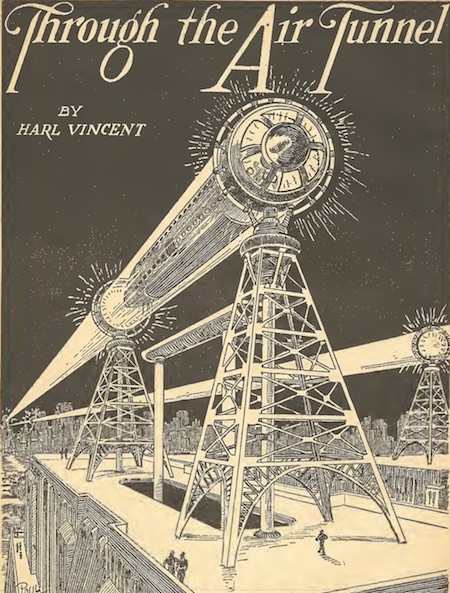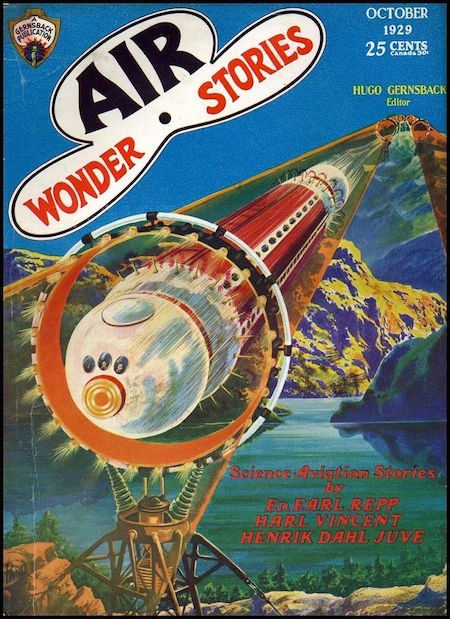Science Fiction
Dictionary
A B C D E F G H I J K L M N O P Q R S T U V W X Y Z
Latest By
Category:
Armor
Artificial
Intelligence
Biology
Clothing
Communication
Computers
Culture
Data Storage
Displays
Engineering
Entertainment
Food
Input Devices
Lifestyle
Living Space
Manufacturing
Material
Media
Medical
Miscellaneous
Robotics
Security
Space Tech
Spacecraft
Surveillance
Transportation
Travel
Vehicle
Virtual
Person
Warfare
Weapon
Work
"...a few centuries of coherent humanist thought, set against a million odd years of evolved killer ape tendency. No-one's going to give you very good odds on humanism, are they?"
- Richard Morgan
| Air Tunnel | ||
| A means of sending trains through the air. |
| "You know how the regular air tunnels operate?”
“Not fully. It has always been quite a mystery to me, but I do know that radio has something to do with it.” “Yes it is radio, of a sort. You see the so-called air tunnels are hollow cylinders of etheric vibrations projected from point to point in the same manner as the regular beams over which industrial power is trans- mitted. In the case of the great transcontinental tunnel there are twin tubes of these vibrations stretching in a huge arc from coast to coast, one for eastbound and the other for westbound traffic. The cars travel within these cylinders. The vibrations themselves are very complex in nature. One component provides insulation against the elements as effectively as though the cars traversed a solid metal tube. Another provides the dark color by day and the brilliance by night that warns standard aircraft of the location of the tubes. Still another energizes the coils in the cars, which coils provide the powerful repulsive force that neutralizes gravity and allows the cars to remain suspended either when stationary or when in motion. But the method of propulsion is what makes travel at extremely high speed impossible.” "But Jimmy, the trip is made in about six hours. Surely that is fast enough for anyone.” “No, dear, it is not fast enough under present traffic demands. Of course the cars travel much faster than the standard aircraft but with my scheme they can be made to operate at five or possibly six times their present velocity. You see, as it is now, the tubes are filled with air at atmospheric pressure and the cars are drawn though this medium by means of motor- driven propellers as on the standard planes. It is the friction of this air that makes higher speeds impossible and it is the removal of the air that was the basis of my original investigations.”
 (Through the Air Tunnel, Harl Vincent, 1929) “You are being a little too technical for me,” laughed Doris, “but I think I get a fair idea of what you are talking about. And it really is interesting. How is the rest of it done?” “By superimposing certain other frequencies on the carrier waves that comprise the tunnel walls. These are the ones I have discovered and am now ready to put to practical use. The first of these causes almost complete evacuation of the interior of the tubes so that the air pressure is negligible. The other is a wave that provides the new propulsive energy for the cars. You see, it will no longer be possible to use the propellers, since there will be no air for these to work on. But my method will draw the cars forward by an inductive action that is capable of providing tremendous speeds. I am afraid I can not describe it to you because it can not be explained without going into great technical detail and that would bore you to extinction. The important thing is that I have my chance at last.” “Oh Jimmy, I am so glad,” breathed Doris eyes shining with pleasure “and I know you will succeed. I just know it.” |
| Technovelgy from Through the Air Tunnel,
by Harl Vincent. Published by Air Wonder Stories in 1929 Additional resources -
|
This story was also the subject of the cover for that issue; here's the cover of the October 1929 Air Wonder Stories:

(Air Wonder Stories, October 1929)
Compare to the submarine tube from An Express of the Future (1895) by Michel Verne, the sub-Atlantic tunnel from Ralph 124c 41 + (1911) by Hugo Gernsback, the pneumatic tube station from Exiles of the Moon (1931) by Nat Schachner (w. AL Zagat), the pneumatic-tube zone from Mechanocracy (1932) by Miles J. Breuer, the vacuum cylinder from Wandl, The Invader (2839) by Ray Cummings, the vortal tube from Whipping Star (1969) by Frank Herbert, the public vehicle tube from The Houses of Iszm (1954) by Jack Vance, the vacutubes from Double Star (1956) by Robert Heinlein and the bounce tube from Double Star (1956) by Robert Heinlein.
Comment/Join this discussion ( 0 ) | RSS/XML | Blog This |
Additional
resources:
More Ideas
and Technology from Through the Air Tunnel
More Ideas
and Technology by Harl Vincent
Tech news articles related to Through the Air Tunnel
Tech news articles related to works by Harl Vincent
Air Tunnel-related
news articles:
- Hyperloop Transport Proposed By Tesla's Elon Musk
- Hyperloop Track Starts Next Year
- President Trump's Wall As Otra Nation Hyperloop
- Hyperloop One Video Shows It Works!
- Hardt Hyperloop Fast Transit In A Can
| SpaceX Rocket Shuttle Point-To-Point On Earth |
| CORLEO Robotic Horse Concept Looks Ready To Ride |
| Futuristic Transit Elevated Bus Never Really Worked |
| Japan Automated Cargo Transport |
Want to Contribute an
Item?
It's easy:
Get the name of the item, a
quote, the book's name and the author's name, and Add
it here.
| <Previous | Next> |
|
|
|
Technovelgy (that's tech-novel-gee!) is devoted to the creative science inventions and ideas of sf authors. Look for the Invention Category that interests you, the Glossary, the Science Fiction Invention Timeline, or see what's New.
|
Science Fiction
Timeline
1600-1899
1900-1939
1940's 1950's
1960's 1970's
1980's 1990's
2000's 2010's
'The observation vehicle was of that peculiar variety used in conveying a large number of people across rough terrain.'
'The real border was defended by... a swarm of quasi-independent aerostats.'
'I ... set my automatic astronomical instruments to searching for a habitable planet.'
'...haven't you a section of the factory where only robot labor is employed?'
'... oblongs were all over the floor and surfaces.'
